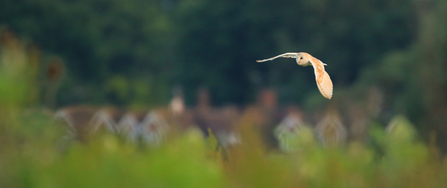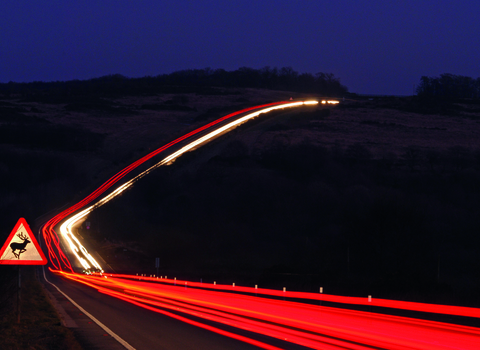More than half of the UK's species are in decline. Here is an overview of the main direct causes of significant trends affecting wildlife and habitats in the UK. The indirect drivers behind these trends, such as changes in demography, consumption, social attitudes and technology, are not covered here.
American historian and writer, Lewis Munford, commented that ‘trend is not destiny’, but nevertheless, long-term trends for wildlife that are being driven by deep-seated economic and social forces are very slow to change and likely to continue long into the future unless very significant effort is made to change them. Many of these direct causes of a changing natural world will have to change significantly if our wildlife is to recover and if people are to develop a stronger personal connection with the natural world.
It's not too late to save our wildlife. Can you help create a Wilder Future for them?
Agriculture
Farming is the UK’s dominant land-use, covering around three-quarters of our land. In recent decades, most agricultural practice has been driven by the EU's common agricultural policy, public funding and financial support for farmers. Given farming covers so much of the UK’s land area is not surprising that it has been the most significant cause of habitat change and species decline across a wide range of plants, animals and fungi[i]. Widespread herbicide and pesticide use and closely managed cultivation regimes mean that there are generally low numbers of invertebrates and wildflowers across wide areas of arable farmland. High livestock stocking-rates or frequent silage cutting affect wildlife in agricultural grassland. Farm specialisation has led to the disappearance of diverse mixed-farmland in many places. Modern farming is also a significant source of nutrient-rich pollution (see ‘Pollution’ below).
Climate change
Climate change is the second-most significant factor currently affecting wildlife populations in the UK[ii]. It is already leading to shifting species ranges and breeding success, changing migration patterns, changes in the annual timing of flowering and the migration of birds and butterflies, food availability and other important ecological factors, including the spread of diseases and different patterns of water availability (including flood and drought).
Fisheries
Fishing pressure is affecting target species, causing damaging by-catch and affecting habitats. The UK National Ecosystem Assessment (2011)[iii] considers seabed trawling to have the greatest impact on wildlife and the marine ecosystem.
Built development
Though built development inevitably covers a far smaller land area than farmed land, its local impact has been and continues to be very significant because it typically removes most natural vegetation immediately associated with the development, seals over natural soils with hard surfacing, disrupts drainage and introduces pollution and disturbance into the area. Major infrastructure projects, urban expansion, new towns and marine development such as offshore windfarms have all caused significant local damage, and have had a very significant cumulative impact. Housing development, in particular, is increasing in the south of England and several other parts of the UK, presenting both a threat and an opportunity (if new housing is built in a way that includes the provision of wildlife habitats).
More development brings with it more damage and disturbance, but as people need access to high quality natural places near to where they live, and as natural places play an increasing role in making the places where we live and work pleasant, attractive and resilient, there is an emerging trend towards more wildlife-friendly development in some places. At sea, recent energy infrastructure development has been on a huge scale, with some individual offshore windfarms covering many square kilometres – often introducing hard engineered structures that act as artificial reefs into areas of soft seabed habitats (such as sand and mud).
Water shortage
Over-abstraction (driven by increasing demand from agricultural, industrial and domestic users), increasing seasonality of rainfall and the historic reduction in the water-storage capacity of landscapes are all having widespread impacts on wetlands and the cost of providing adequate water supplies – particularly in London and South East England[iv].
Pollution
Whilst sulphur dioxide air pollution has been largely addressed in recent years, other pollutants are widespread. The sea is the ultimate sink for persistent pollutants such as PCBs, which are affecting populations of European dolphins[v]. It also receives large quantities of eroded soil. Nutrient levels are rising in all parts of the environment – particularly in soils and freshwaters. This is principally from agriculture – from the application of nitrogen- and phosphate-based fertilizers – and transport – which leads to raised dissolved nitrogen in rainfall.
Invasive non-native species
Invasive non-native species include long-standing threats to native animals, such as the American mink (which has had a marked impact on the water vole), the American signal crayfish (which is a significant threat to the native white clawed crayfish), and the many inshore marine species being brought from around the world in the ballast water of cargo ships. Invasive non-native plants, such as Japanese knotweed and giant hogweed, are widespread along many watercourses. A recent survey indicated that non-native vegetation makes up nearly 2% of Britain’ countryside[vi].
Disease
Changing climate and other environmental conditions, plus the global movement of people and transportation of goods (particularly natural produce such as plants, animals, food and timber), have brought several diseases to the UK in recent years, or created conditions that encourage their spread. Several of these pose significant threats to individual species (e.g. ash dieback, crayfish plague, squirrel pox virus), or groups (Chytrid fungus affecting amphibians). Some diseases that are carried by mammals (such as rabies in bats or leprosy in red squirrels), birds or insects are affecting, or could affect, public opinion and policy towards wildlife.
Land Management for Wildlife
Wildlife has been hugely affected by changes to the way land is managed, away from beneficial traditional approaches (such as a huge reduction in the coppicing of woodland[vii]), or the continuation of management that is known to cause significant damage to wildlife-rich habitats (such as widespread burning of grouse moors and overgrazing in the uplands[viii]). Conversely, sustaining or introducing appropriate management to keep habitats in good condition has been vital for maintaining species diversity and habitat character. The balance between land management that is ‘good’ for wildlife and land management that is ‘bad’ has been shifting in the wrong direction for decades.
Places managed in ways that are sympathetic to the needs of wildlife have become smaller, more isolated from each other, and less numerous, but on land managed specifically for nature conservation purposes, and where land managers are willing and able to manage it to improve its wildlife value, a lot has been achieved. Over the last fifteen years, in particular – as enlightened land owners and managers have developed a ‘landscape-scale approach’ to nature’s recovery – significant habitat creation and restoration has been achieved. A well managed, wildlife-rich nature network that spans the UK, improving, expanding and connecting places that are hospitable to communities of wild plants and animals does not yet exist. But it is starting to emerge from past work to protect and conserve the natural world, despite the many obstacles.

© Jon Hawkins - Surrey Hills Photography
References
[i] Burns, F., Eaton, M.A., Barlow, K.E., Beckmann, B.C., Brereton, T., Brooks, D.R. et al. (2016) Agricultural Management and Climatic Change Are the Major Drivers of Biodiversity Change in the UK. PLoS ONE 11(3): e0151595. http://journals.plos.org/plosone/article?id=10.1371/journal.pone.0151595
[ii] Burns et al. (2016) Agricultural Management and Climatic Change Are the Major Drivers of Biodiversity Change in the UK. op. cit.
[iii] UK NEA (2011) The UK National Ecosystem Assessment Technical Report. Chapter 12: Marine. UNEP-WCMC, Cambridge. Accessible from http://uknea.unep-wcmc.org/Resources/tabid/82/Default.aspx
[iv] Royal Commission on Environmental Pollution (2011) Demographic Change & the Environment. Twenty-ninth report of the RCEP, February 2011. http://webarchive.nationalarchives.gov.uk/20110303145146/http://www.rcep.org.uk/reports/29-demographics/documents/Demography_final_report.pdf
[v] Jepson, P.D., Deaville, R., Barber, J.L., Aguilar, À., Borrell, A., Murphy, S., Barry, J., Brownlow, A., Barnett, J., Berrow, S., Cunningham, A.A., Davison, N.J., ten Doeschate, M., Esteban, R., Ferreira, M., Foote, A.D., Genov, T., Giménez., J., Loveridge, L., Llavona, Á., Martin,V., Maxwell, D.L., Papachlimitzou, A., Penrose, R., Perkins, M.W., Smith, B., de Stephanis, R., Tregenza, N., Verbogh, P., Fernandez, A. & Law, R.J. (2016) PCB pollution continues to impact populations of orcas and other dolphins in European waters. Scientific Reports 6,18573. http://www.nature.com/articles/srep18573
[vi] Centre for Ecology & Hydrology (2007) Countryside Survey: Executive Summary for the ‘UK Headline Messages’ and ‘UK Results from 2007’ http://www.countrysidesurvey.org.uk/sites/default/files/CS_UK_2007_ES_English.pdf
[vii] Carey, P.D. (2008) Results from 2007 Countryside Survey. op. cit.
[viii] RSPB & 24 other organisations (2013) State of Nature. op. cit.

